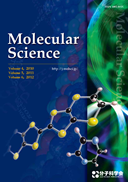Volume 9, Issue 1
Displaying 1-8 of 8 articles from this issue
- |<
- <
- 1
- >
- >|
Article
-
2015 Volume 9 Issue 1 Pages A0074-
Published: 2015
Released on J-STAGE: August 31, 2015
Download PDF (858K)
Award Accounts
-
2015 Volume 9 Issue 1 Pages A0075-
Published: 2015
Released on J-STAGE: August 31, 2015
Download PDF (2188K) -
2015 Volume 9 Issue 1 Pages A0076-
Published: 2015
Released on J-STAGE: August 31, 2015
Download PDF (2255K) -
2015 Volume 9 Issue 1 Pages A0077-
Published: 2015
Released on J-STAGE: August 31, 2015
Download PDF (3384K) -
2015 Volume 9 Issue 1 Pages A0078-
Published: 2015
Released on J-STAGE: August 31, 2015
Download PDF (2466K)
Review
-
2015 Volume 9 Issue 1 Pages A0079-
Published: 2015
Released on J-STAGE: August 31, 2015
Download PDF (1456K) -
2015 Volume 9 Issue 1 Pages A0080-
Published: 2015
Released on J-STAGE: August 31, 2015
Download PDF (2818K) -
2015 Volume 9 Issue 1 Pages A0081-
Published: 2015
Released on J-STAGE: August 31, 2015
Download PDF (3823K)
- |<
- <
- 1
- >
- >|
